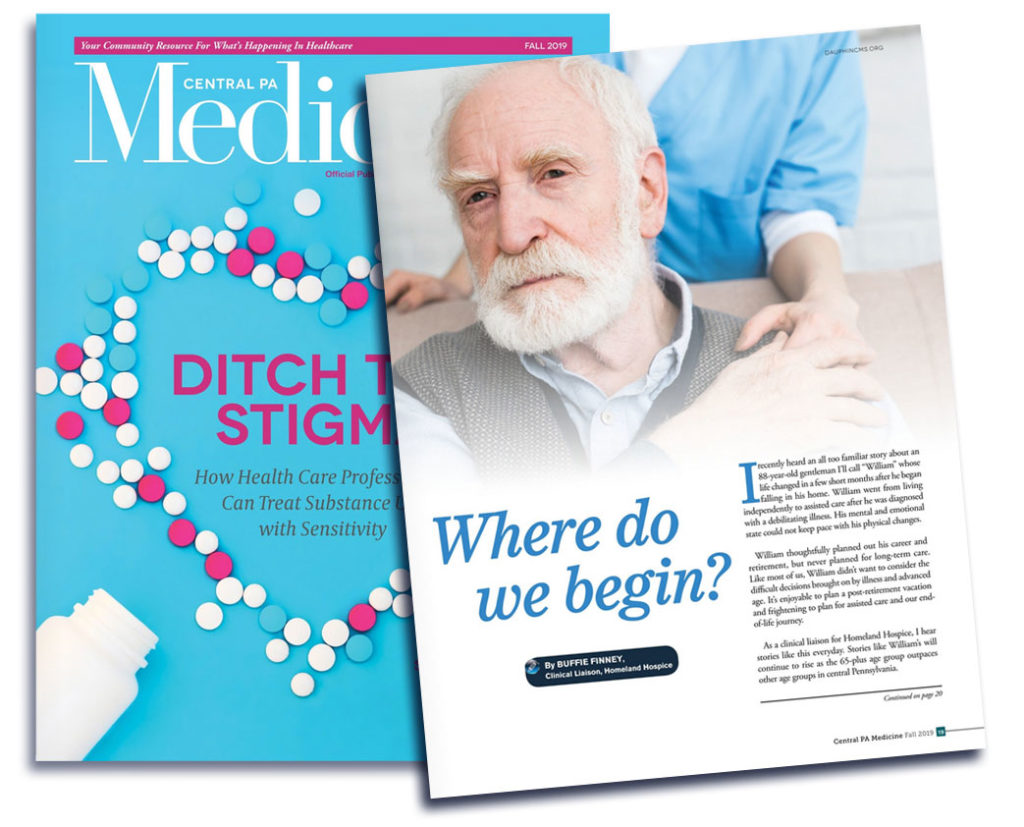Where do we begin?
Authored by Buffie Finney, Clinical Liaison for Homeland Hospice, the following article was first published in the Fall issue of “Central PA Medicine,” the official publication of the Dauphin County Medical Society.
 I recently heard an all too familiar story about an 88-year-old gentleman I’ll call “William” whose life changed in a few short months after he began falling in his home. William went from living independently to assisted care after he was diagnosed with a debilitating illness. His mental and emotional state could not keep pace with his physical changes. William thoughtfully planned out his career and retirement, but never planned for long-term care. Like most of us, William didn’t want to consider the difficult decisions brought on by illness and advanced age. It’s enjoyable to plan a post-retirement vacation and frightening to plan for assisted care and our end-of- life journey.
I recently heard an all too familiar story about an 88-year-old gentleman I’ll call “William” whose life changed in a few short months after he began falling in his home. William went from living independently to assisted care after he was diagnosed with a debilitating illness. His mental and emotional state could not keep pace with his physical changes. William thoughtfully planned out his career and retirement, but never planned for long-term care. Like most of us, William didn’t want to consider the difficult decisions brought on by illness and advanced age. It’s enjoyable to plan a post-retirement vacation and frightening to plan for assisted care and our end-of- life journey.
As a clinical liaison for Homeland Hospice, I hear stories like this every day. Stories like William’s will continue to rise as the 65-plus age group outpaces other age groups in central Pennsylvania.
 My advice to patients and families is to take it one step at a time. Like any journey, identify where you are today and where you can be in the near future safely. This may not be where the patient wants to be, but where he or she needs to be based on the diagnosis. This plan of care may continue to change depending on how the patient responds to factors like rehabilitation or the progression of the disease.
My advice to patients and families is to take it one step at a time. Like any journey, identify where you are today and where you can be in the near future safely. This may not be where the patient wants to be, but where he or she needs to be based on the diagnosis. This plan of care may continue to change depending on how the patient responds to factors like rehabilitation or the progression of the disease.
The first step is a life assessment with the patient, family members and physician to develop a care plan based on the patient’s diagnosis and realistic goals. This often occurs after a patient has been hospitalized. Hospital stays can be short, making the life assessment a critical step in planning a holistic treatment of care.
It’s not unusual for patients and families to be surprised to learn the patient will be discharged. Families may find comfort knowing their loved one is safe and cared for in the hospital and mentally put off making the difficult decisions about next steps. Often, patients and their families will make decisions based on what they want, like their loved one returning home, and not on their new reality. Without proper support in place, a hasty decision to return home could result in a fall or injury causing a repeat hospitalization and further decline in health.
Once the care plan is in place and implemented, the patient develops a new baseline or “new normal” based on the successful or unsuccessful outcome of treatment such as rehab or medications. In a best-case scenario, the patient will fully recover and can return to his or her home.
More often, the patient is facing greater physical and/or mental challenges and must face difficult decisions about acute or subacute rehab or hospice care. In my profession, I see this as a defining moment for patients and families. It’s an emotional and overwhelming time to learn and understand the impact of these choices. Often the decision is made in haste, as the patient needs to find a place to go upon discharge from the hospital.
Patients, families and their health care team want to try every possible opportunity to help the patient return to his or her former self. This often leads to acute rehab, which includes three hours of therapy a day to help patients reach this goal. This type of therapy is financially appealing as it’s a covered service by insurance providers.
Far too often, patients cannot keep up with the intensive therapy. When this happens, the insurance coverage ceases. Patients will be discharged to their homes or a skilled nursing facility to receive subacute care, which offers limited therapy. This type of care is private pay or paid by medical assistance.
Patients and their families are once again on the roller coaster of difficult decisions. The gravity of the patient’s age and disease progression settles in as does questions about affording long-term care. Most importantly, families must consider the quality of life of their loved one during this season of life.
As health care professionals, we’re the collective lifelines for patients and their families. We may not know all of the answers, but we know who to bring to the table to answer questions about prognosis, treatments and insurance coverage, among other important topics. This conversation may include the end-of-life journey through hospice care. The conversation can be difficult, but the benefits are immeasurable.
For patients who choose hospice care, it’s best to get started as soon as possible. Hospice provides a team of support to give families more time to absorb the emotional stress of their new reality. This is precious time for families to spend together as well as deal with any unresolved issues. Most importantly, the patient’s pain and symptoms are managed.
Homeland Hospice often assists physicians with end-of-life, advance care planning conversations. We also can be a tremendous asset bringing comfort, acceptance and peace to the terminally ill and their loved ones. Patients can receive hospice care anywhere they call home. This could be a residence or an assisted care facility.
Planning for the final steps in our journey or that of a loved one is overwhelming and emotional, but it’s not a journey anyone has to plan independently without professional guidance. No one needs to go through this alone. When a life assessment indicates a medical cure is no longer possible or the decision to stop aggressive treatment has been made, hospice may provide the most comfort and peace for patients and their families.
If you have any questions about Homeland Hospice, please contact us.


